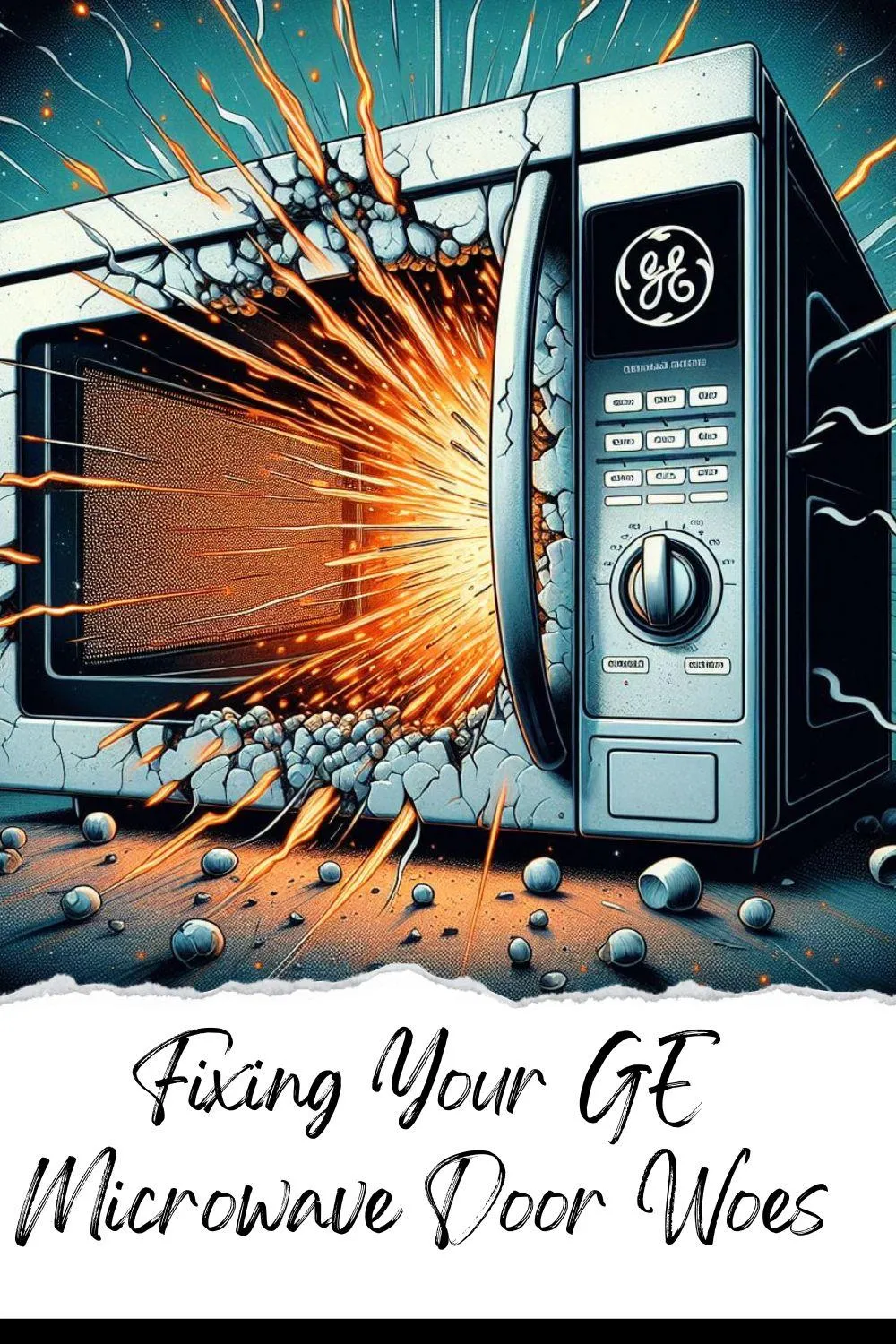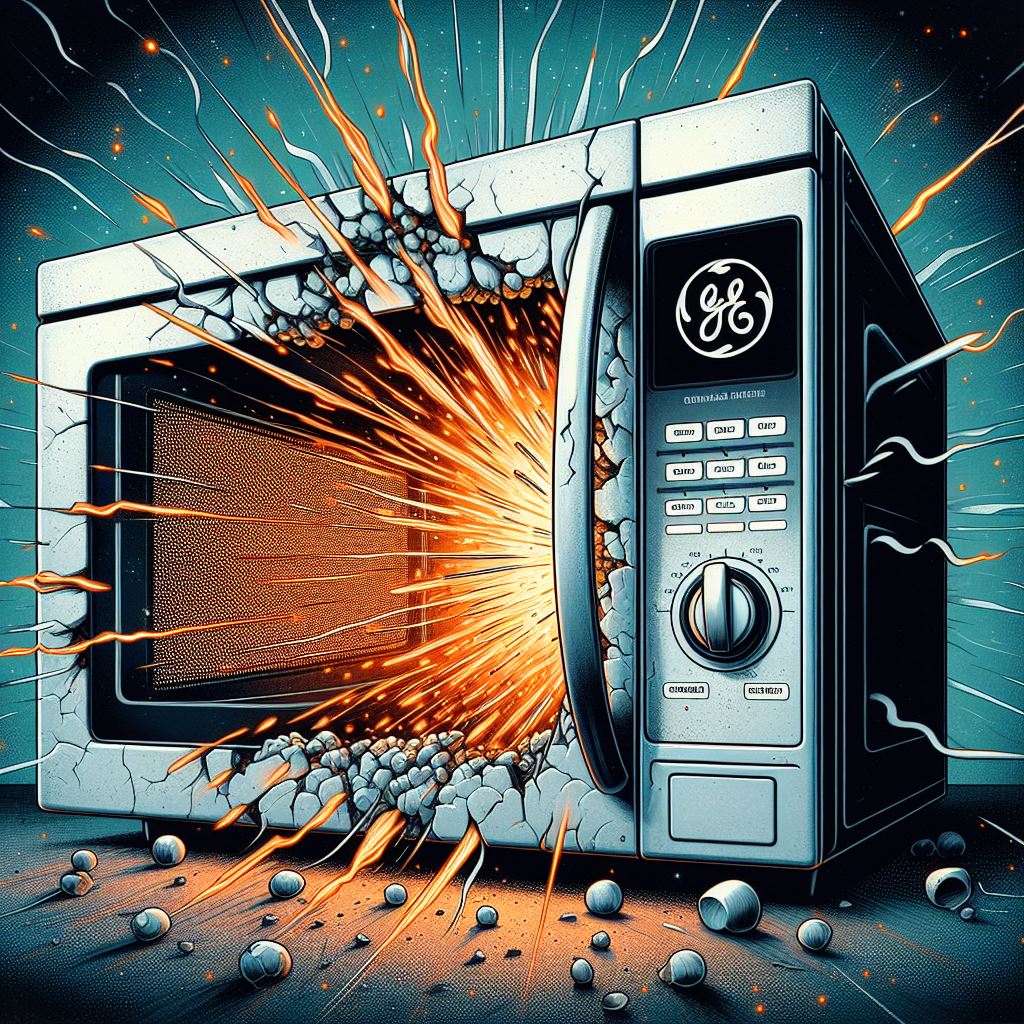THE FASTEST TOOLS IN TOWN
ZIP APPLIANCE REPAIR & SERVICE
Phone: (559) 272-4265
Phone: (559) 272-4265
Appliance Repair Tips For Fresno, CA Residents

Troubleshooting GE Microwave Door Problems
“Mastering the art of troubleshooting microwave door problems isn't just about fixing appliances; it's about reclaiming kitchen confidence and keeping the culinary creativity flowing.” - Appliance Boss
Introduction:
In the heart of every kitchen lies a trusty appliance: the microwave. Its convenience and efficiency have revolutionized meal preparation, but behind its sleek exterior lies a crucial component often overlooked—the microwave door. Understanding its importance is key to maintaining the functionality of your appliance.
Understanding the Importance of a Functional Microwave Door
The microwave door serves as a barrier, preventing harmful radiation from escaping while ensuring optimal cooking conditions. Its proper operation is vital for both safety and performance. Without a functional door, your microwave's efficiency and effectiveness are compromised.

Overview of Common Issues with GE Microwave Doors
GE microwaves are renowned for their quality, but even the most reliable appliances can encounter problems. From loose hinges to faulty seals, understanding the common issues that plague GE microwave doors is the first step in troubleshooting and resolving potential problems.
Identifying the Problem
Visual Inspection: Signs of Wear and Tear
A visual inspection can reveal telltale signs of wear and tear on your microwave door. Look for cracks, dents, or warping in the door itself, as well as any damage to the surrounding frame or hinges. These visual cues can indicate underlying issues that need addressing.
Testing Functionality: Checking for Proper Alignment
Proper alignment is crucial for the smooth operation of your microwave door. Test its functionality by opening and closing it several times, paying attention to any resistance or misalignment. A door that doesn't close properly may indicate hinge or alignment issues.
Listening for Strange Noises: Indicators of Mechanical Issues
Unusual noises, such as squeaking or grinding, can signal mechanical problems within the door mechanism. Listen closely while opening and closing the door to identify any abnormal sounds. Addressing these issues early can prevent further damage and ensure smooth operation.
Common GE Microwave Door Issues
Loose Hinges: Causes and Effects
Loose hinges are a common issue that can lead to a variety of problems, including difficulty opening or closing the door and improper sealing. Causes may include wear and tear over time or improper installation. Tightening or replacing the hinges is often necessary to resolve this issue.
Misaligned Door: Impact on Performance
A misaligned door can disrupt the proper functioning of your microwave, leading to uneven cooking or difficulty closing the door securely. Adjusting the alignment of the door hinges or frame can help restore proper operation and prevent further issues.
Faulty Latches: Preventing Proper Closure
Faulty latches can prevent the microwave door from closing securely, compromising both safety and performance. Inspect the latch mechanism for any signs of damage or wear, and replace if necessary to ensure a tight seal.
Damaged Seals: Compromising Efficiency
The door seal plays a crucial role in maintaining the integrity of your microwave's cooking environment. Damage or deterioration of the seal can lead to heat loss, uneven cooking, and energy inefficiency. Replacing the seal is essential for restoring optimal performance.
Cracked or Broken Glass: Safety Concerns
A cracked or broken microwave door glass poses serious safety hazards, as it compromises the containment of microwave radiation. If you notice any damage to the glass, refrain from using the microwave until it has been repaired or replaced by a qualified technician.
DIY Fixes for Minor Issues
Tightening Loose Hinges: Step-by-Step Guide
If you've identified loose hinges as the culprit behind your microwave door issues, tightening them is a relatively simple fix. Using a screwdriver, carefully tighten the screws holding the hinges in place, ensuring a secure fit without over-tightening.
Adjusting Door Alignment: Tips and Tricks
To correct a misaligned microwave door, start by loosening the hinge screws slightly to allow for adjustment. Gently lift or lower the door to achieve proper alignment, then tighten the screws once again. Repeat the process as needed until the door closes smoothly.
Lubricating Latches: Ensuring Smooth Operation
If your microwave door latch is sticking or difficult to operate, lubricating it can help restore smooth functionality. Apply a small amount of silicone or lithium grease to the latch mechanism, being careful not to overapply. Test the latch to ensure it moves freely.
Replacing Door Seals: Simple Solutions for a Tight Seal
Replacing a damaged door seal is a straightforward DIY task that can greatly improve your microwave's performance. Remove the old seal carefully, taking note of its placement, and install the new seal in its position. Ensure a snug fit to maintain proper sealing.
Repairing or Replacing Glass: Safety First
While repairing minor cracks in microwave door glass is possible, it's often safer and more practical to replace the glass entirely. Consult a professional technician for this task to ensure proper installation and adherence to safety standards.
Advanced Troubleshooting Techniques
Testing Door Switches: Ensuring Proper Functionality
The door switches play a critical role in the operation of your microwave, ensuring that it only operates when the door is securely closed. Use a multimeter to test the continuity of the switches, replacing any faulty ones to restore proper functionality.
Checking Electrical Connections: Addressing Power Issues
Electrical issues can also contribute to microwave door problems. Inspect the electrical connections to ensure they are secure and free from damage or corrosion. Tighten any loose connections and replace any damaged wires or components as needed.
Inspecting Control Panel: Identifying Electronic Malfunctions
A malfunctioning control panel can cause a variety of issues with your microwave, including problems with the door. Inspect the control panel for any signs of damage or malfunction, such as unresponsive buttons or error codes. Repair or replace the panel as necessary.
Assessing Internal Components: Addressing Mechanism Problems
If all else fails, it may be necessary to disassemble the microwave door mechanism to identify and address underlying issues. Inspect internal components such as springs, hinges, and latches for signs of damage or wear, replacing any faulty parts as needed.

Seeking Professional Assistance
Knowing When to Call a Technician
While many microwave door issues can be addressed through DIY methods, some problems may require the expertise of a professional technician. If you're unsure about the cause of your microwave door problems or uncomfortable performing repairs yourself, don't hesitate to seek professional assistance.
Choosing a Qualified Repair Service
When selecting a repair service for your GE microwave, it's important to choose a qualified and reputable provider. Look for technicians who are certified to work on GE appliances and have experience with microwave repairs. Reading reviews and asking for recommendations can help you find a reliable service provider.
Understanding Warranty Coverage
Before scheduling repairs for your GE microwave, review the warranty coverage provided by the manufacturer. Some issues may be covered under warranty, saving you money on repairs. Be sure to follow the manufacturer's guidelines for warranty service to avoid voiding coverage.
Preventive Maintenance Tips
Regular Cleaning: Keeping Components in Top Condition
Regular cleaning of your microwave, including the door and surrounding components, can help prevent issues and prolong its lifespan. Use a mild detergent and warm water to wipe down the exterior and interior surfaces, paying special attention to the door seals and hinges.
Avoiding Slamming: Preserving Door Integrity
Avoiding slamming the microwave door shut can help prevent damage to hinges, seals, and other components. Encourage household members to close the door gently but firmly to preserve its integrity and prevent premature wear and tear.
Using Microwave Safely: Minimizing Wear and Tear
Using your microwave according to manufacturer guidelines and safety recommendations can help minimize wear and tear on the door and internal components. Avoid overloading the microwave, using appropriate cookware, and following recommended cooking times and power levels.
Scheduled Inspections: Proactive Approach to Maintenance
Implementing a regular inspection schedule for your microwave can help catch potential issues early, preventing them from escalating into major problems. Set aside time every few months to visually inspect the door, hinges, seals, and latches for any signs of wear, damage, or malfunction.
Conclusion
Recap of Troubleshooting Techniques
Troubleshooting GE microwave door problems requires a systematic approach, from identifying the issue to implementing appropriate solutions. By following the troubleshooting techniques outlined in this article, you can address common door issues and restore your microwave's functionality with ease.
Importance of Prompt Attention to Microwave Door Issues
Prompt attention to microwave door issues is essential for maintaining the safety, efficiency, and longevity of your appliance. Ignoring or neglecting door problems can lead to further damage, compromised performance, and even safety hazards. By addressing issues promptly, you can ensure that your microwave continues to serve you well for years to come.
Ensuring Longevity and Efficiency of Your GE Microwave
Taking proactive steps to troubleshoot and address door problems, as well as implementing preventive maintenance measures, is key to ensuring the longevity and efficiency of your GE microwave. By caring for your appliance properly and addressing issues as they arise, you can enjoy reliable performance and delicious meals for years to come.

Troubleshooting GE Microwave Door Problems
“Mastering the art of troubleshooting microwave door problems isn't just about fixing appliances; it's about reclaiming kitchen confidence and keeping the culinary creativity flowing.” - Appliance Boss
Introduction:
In the heart of every kitchen lies a trusty appliance: the microwave. Its convenience and efficiency have revolutionized meal preparation, but behind its sleek exterior lies a crucial component often overlooked—the microwave door. Understanding its importance is key to maintaining the functionality of your appliance.
Understanding the Importance of a Functional Microwave Door
The microwave door serves as a barrier, preventing harmful radiation from escaping while ensuring optimal cooking conditions. Its proper operation is vital for both safety and performance. Without a functional door, your microwave's efficiency and effectiveness are compromised.

Overview of Common Issues with GE Microwave Doors
GE microwaves are renowned for their quality, but even the most reliable appliances can encounter problems. From loose hinges to faulty seals, understanding the common issues that plague GE microwave doors is the first step in troubleshooting and resolving potential problems.
Identifying the Problem
Visual Inspection: Signs of Wear and Tear
A visual inspection can reveal telltale signs of wear and tear on your microwave door. Look for cracks, dents, or warping in the door itself, as well as any damage to the surrounding frame or hinges. These visual cues can indicate underlying issues that need addressing.
Testing Functionality: Checking for Proper Alignment
Proper alignment is crucial for the smooth operation of your microwave door. Test its functionality by opening and closing it several times, paying attention to any resistance or misalignment. A door that doesn't close properly may indicate hinge or alignment issues.
Listening for Strange Noises: Indicators of Mechanical Issues
Unusual noises, such as squeaking or grinding, can signal mechanical problems within the door mechanism. Listen closely while opening and closing the door to identify any abnormal sounds. Addressing these issues early can prevent further damage and ensure smooth operation.
Common GE Microwave Door Issues
Loose Hinges: Causes and Effects
Loose hinges are a common issue that can lead to a variety of problems, including difficulty opening or closing the door and improper sealing. Causes may include wear and tear over time or improper installation. Tightening or replacing the hinges is often necessary to resolve this issue.
Misaligned Door: Impact on Performance
A misaligned door can disrupt the proper functioning of your microwave, leading to uneven cooking or difficulty closing the door securely. Adjusting the alignment of the door hinges or frame can help restore proper operation and prevent further issues.
Faulty Latches: Preventing Proper Closure
Faulty latches can prevent the microwave door from closing securely, compromising both safety and performance. Inspect the latch mechanism for any signs of damage or wear, and replace if necessary to ensure a tight seal.
Damaged Seals: Compromising Efficiency
The door seal plays a crucial role in maintaining the integrity of your microwave's cooking environment. Damage or deterioration of the seal can lead to heat loss, uneven cooking, and energy inefficiency. Replacing the seal is essential for restoring optimal performance.
Cracked or Broken Glass: Safety Concerns
A cracked or broken microwave door glass poses serious safety hazards, as it compromises the containment of microwave radiation. If you notice any damage to the glass, refrain from using the microwave until it has been repaired or replaced by a qualified technician.
DIY Fixes for Minor Issues
Tightening Loose Hinges: Step-by-Step Guide
If you've identified loose hinges as the culprit behind your microwave door issues, tightening them is a relatively simple fix. Using a screwdriver, carefully tighten the screws holding the hinges in place, ensuring a secure fit without over-tightening.
Adjusting Door Alignment: Tips and Tricks
To correct a misaligned microwave door, start by loosening the hinge screws slightly to allow for adjustment. Gently lift or lower the door to achieve proper alignment, then tighten the screws once again. Repeat the process as needed until the door closes smoothly.
Lubricating Latches: Ensuring Smooth Operation
If your microwave door latch is sticking or difficult to operate, lubricating it can help restore smooth functionality. Apply a small amount of silicone or lithium grease to the latch mechanism, being careful not to overapply. Test the latch to ensure it moves freely.
Replacing Door Seals: Simple Solutions for a Tight Seal
Replacing a damaged door seal is a straightforward DIY task that can greatly improve your microwave's performance. Remove the old seal carefully, taking note of its placement, and install the new seal in its position. Ensure a snug fit to maintain proper sealing.
Repairing or Replacing Glass: Safety First
While repairing minor cracks in microwave door glass is possible, it's often safer and more practical to replace the glass entirely. Consult a professional technician for this task to ensure proper installation and adherence to safety standards.
Advanced Troubleshooting Techniques
Testing Door Switches: Ensuring Proper Functionality
The door switches play a critical role in the operation of your microwave, ensuring that it only operates when the door is securely closed. Use a multimeter to test the continuity of the switches, replacing any faulty ones to restore proper functionality.
Checking Electrical Connections: Addressing Power Issues
Electrical issues can also contribute to microwave door problems. Inspect the electrical connections to ensure they are secure and free from damage or corrosion. Tighten any loose connections and replace any damaged wires or components as needed.
Inspecting Control Panel: Identifying Electronic Malfunctions
A malfunctioning control panel can cause a variety of issues with your microwave, including problems with the door. Inspect the control panel for any signs of damage or malfunction, such as unresponsive buttons or error codes. Repair or replace the panel as necessary.
Assessing Internal Components: Addressing Mechanism Problems
If all else fails, it may be necessary to disassemble the microwave door mechanism to identify and address underlying issues. Inspect internal components such as springs, hinges, and latches for signs of damage or wear, replacing any faulty parts as needed.

Seeking Professional Assistance
Knowing When to Call a Technician
While many microwave door issues can be addressed through DIY methods, some problems may require the expertise of a professional technician. If you're unsure about the cause of your microwave door problems or uncomfortable performing repairs yourself, don't hesitate to seek professional assistance.
Choosing a Qualified Repair Service
When selecting a repair service for your GE microwave, it's important to choose a qualified and reputable provider. Look for technicians who are certified to work on GE appliances and have experience with microwave repairs. Reading reviews and asking for recommendations can help you find a reliable service provider.
Understanding Warranty Coverage
Before scheduling repairs for your GE microwave, review the warranty coverage provided by the manufacturer. Some issues may be covered under warranty, saving you money on repairs. Be sure to follow the manufacturer's guidelines for warranty service to avoid voiding coverage.
Preventive Maintenance Tips
Regular Cleaning: Keeping Components in Top Condition
Regular cleaning of your microwave, including the door and surrounding components, can help prevent issues and prolong its lifespan. Use a mild detergent and warm water to wipe down the exterior and interior surfaces, paying special attention to the door seals and hinges.
Avoiding Slamming: Preserving Door Integrity
Avoiding slamming the microwave door shut can help prevent damage to hinges, seals, and other components. Encourage household members to close the door gently but firmly to preserve its integrity and prevent premature wear and tear.
Using Microwave Safely: Minimizing Wear and Tear
Using your microwave according to manufacturer guidelines and safety recommendations can help minimize wear and tear on the door and internal components. Avoid overloading the microwave, using appropriate cookware, and following recommended cooking times and power levels.
Scheduled Inspections: Proactive Approach to Maintenance
Implementing a regular inspection schedule for your microwave can help catch potential issues early, preventing them from escalating into major problems. Set aside time every few months to visually inspect the door, hinges, seals, and latches for any signs of wear, damage, or malfunction.
Conclusion
Recap of Troubleshooting Techniques
Troubleshooting GE microwave door problems requires a systematic approach, from identifying the issue to implementing appropriate solutions. By following the troubleshooting techniques outlined in this article, you can address common door issues and restore your microwave's functionality with ease.
Importance of Prompt Attention to Microwave Door Issues
Prompt attention to microwave door issues is essential for maintaining the safety, efficiency, and longevity of your appliance. Ignoring or neglecting door problems can lead to further damage, compromised performance, and even safety hazards. By addressing issues promptly, you can ensure that your microwave continues to serve you well for years to come.
Ensuring Longevity and Efficiency of Your GE Microwave
Taking proactive steps to troubleshoot and address door problems, as well as implementing preventive maintenance measures, is key to ensuring the longevity and efficiency of your GE microwave. By caring for your appliance properly and addressing issues as they arise, you can enjoy reliable performance and delicious meals for years to come.
If your dryer has been giving you problems, contact Zip Appliance Repair & Service at (559) 272-4265

Appliance Repair In A Zip
If you need a dryer repair call our Team at (559) 272-4265, or visit our online scheduling page to request service.
Appliance Repair
HAVE A QUESTION, CALL (559) 272-4265

Online Offers
Take advantage of our online discount offers - save time and money...

Residential & Commercial appliances
See what our company can do for you

Appliance Repair Tips
If your appliance is not working properly...

1405 Commercial Way ste 100
Bakersfield, CA 93309
Lic # 1116346
Equipment We Sevice
- A Call To Confirm Your Appointment Time
- A Email Detailing Your Assigned Technician
- Information Needed Before The Repair Can Be Started
- An Estimate Of Work To Be Done
© 2025 ZIP APPLIANCE REPAIR & SERVICE LLC







